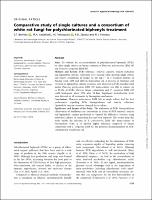Comparative study of single cultures and a consortium of white rot fungi for polychlorinated biphenyls treatment
Date
2021-03-05Author
Benítez, Silvana Florencia
Sadañoski, Marcela Alejandra
Velázquez, Juan Ernesto
Zapata, Pedro Darío
Fonseca, María Isabel
Metadata
Show full item recordAbstract
Aims: To evaluate the mycoremediation of polychlorinated biphenyls (PCBs)
by either single cultures or binary consortia of Pleurotus pulmonarius LBM 105
and Trametes sanguinea LBM 023.
Methods and Results: PCBs tolerance, removal capacity, toxicity reduction
and ligninolytic enzyme expression were assessed when growing single culture
and binary consortium of fungus in 217 mg l−1 of a technical mixture of
Aroclor 1242, 1254 and 1260 in transformer oil. A decrease in tolerance and
variation in ligninolytic enzyme secretion were observed in PCB-amended solid
media. Pleurotus pulmonarius LBM 105 mono-culture was able to remove up
to 954% of PCBs, whereas binary consortium and T. sanguinea LBM 023
could biodegrade about 55% after 24 days. Significant detoxification levels
were detected in all treatments by biosorption mechanism.
Conclusions: Pleurotus pulmonarius LBM 105 in single culture had the best
performance regarding PCBs biodegradation and toxicity reduction.
Ligninolytic enzyme secretion changed in co-culture.
Significance and Impact of the Study: The evaluation of PCBs bioremediation
effectiveness of basidiomycetes consortium in terms of PCB removal, toxicity
and ligninolytic enzyme production to unravel the differences between using
individual cultures or consortium has not been reported. The results from this
study enable the selection of P. pulmonarius LBM 105 mono-culture to
bioremediate PCBs as it showed higher efficiency compared to binary
consortium with T. sanguinea LBM 023 for potential decontamination of PCB-
contaminated transformer oil.
Collections
The following license files are associated with this item:



